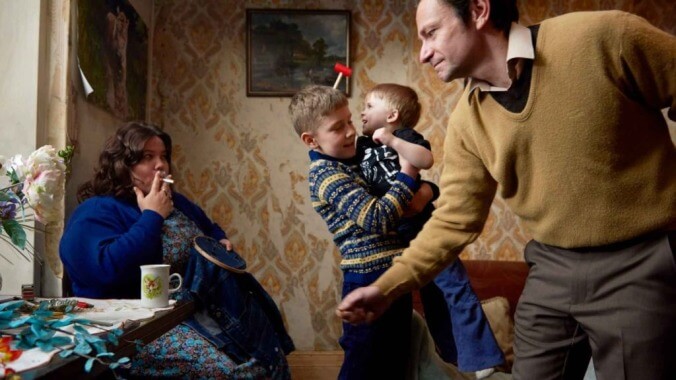Ray & Liz draws an intensely specific portrait of a troubled working-class upbringing

Memories both joyous and painful are recreated and thus transformed in Distant Voices, Still Lives and The Long Day Closes, Terence Davies’ 1988 and 1992 masterpieces about his white working-class upbringing. Some thirty years on, Ray & Liz, an autobiographical debut feature from Richard Billingham, attempts to do the same for the director’s own working-class childhood in 1980s Birmingham. An English photographer best known for his 1996 compilation Ray’s A Laugh—a stark, claustrophobic portrait of his alcoholic father and a look at his generally troubled home life—Billingham has, for over 20 years, used his camera to create personal, intensely specific images that double as snapshots of urban poverty and parental neglect. In that respect, Ray & Liz extends, and also interrogates the impulse to transform life into art—thus probing at the very limits of memory.
The matter of whose memory is being put on screen is, at first, rather unclear. Structured as a triptych, Ray & Liz opens in the approximate present, in a decrepit high-rise apartment where Billingham’s now-elderly father Ray (Patrick Romer) lives alone, whiling away his days drinking a seemingly endless supply of noxious-looking home brew. From that first location—which the film returns to intermittently—it then dissolves to a pair of extended flashbacks. A marvel of claustrophobic tension, the first of these observes a babysitting gig gone extremely wrong, as Ray’s mentally challenged brother, Lol (Tony Way), is left in charge of Richard’s 2-year-old younger brother, Jason (Callum Slater), but is gradually manipulated by a sadistic lodger (Sam Gittins) into drinking the family’s cache of alcohol. Vomit, abuse, and a sharp knife are soon thrown in the queasy mix, and it’s a small miracle that Jason even survives.
If that makes Ray & Liz sound like a run-of-the-mill portrait of British working-class miserablism, that’s because Billingham’s film doesn’t entirely sidestep that designation. The film is replete with heightened detail that could only come from personal memory, which the director, working with cinematographer Daniel Landin (Under The Skin), captures on 16mm in the Academy ratio in order to evoke the film’s period texture. But Billingham too often plays the setting’s pungent specifics—a dog lapping up vomit, Ray stepping into a pool of piss—for grotesque comedy. Refreshingly, he makes no attempt to “understand” or “explain” the neglectful, often abusive behavior of his parents (played in their younger incarnations by Justin Salinger and Ella Smith), preferring to convey a child’s point of view. But given that most of Billingham’s efforts seem to have been channeled into the film’s obsessive, meticulous art direction, he also ends up transforming scenes into mere containers for his sordid recollections.
Much more successful—and, at times, moving—are the occasions where Billingham departs from the miserablist proceedings, or at least offers some welcome tonal variation. The third section almost exclusively follows Jason (Sam Plant), now about 7 or 8 years old, as he’s left to his own devices, wandering the area surrounding the family’s apartment. He will later be found shivering in a stranger’s shed (and subsequently put into foster care), but for a time, we see him revel in reckless freedom: visiting a zoo, wandering by a raging bonfire, and watching a firecracker display on Guy Fawkes night. Although it would be easy to file this passage—and the film as a whole—as second-rate Davies, Billingham’s methods are ultimately rather different. What’s crucial is that although Ray & Liz certainly moves like a memory play, the director has chosen to recreate events that he himself could not have experienced. This seeming contradiction animates Ray & Liz, a film in which the memories you can’t shake and the memories you won’t let go become indistinguishable from the ones you never had.